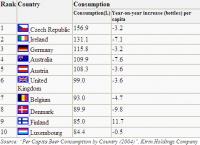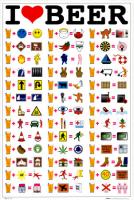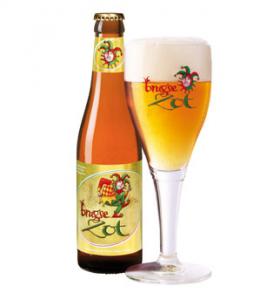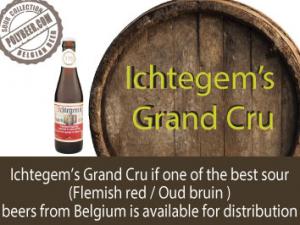Articles » Beer Consuption in the World

Beer is a common alcoholic beverage that is made from barley, yeast, hops, water, and grains. Its alcoholic content comes from the process of fermentation, which converts the simple sugars (carbohydrates) in the grains and barley into alcohol. The oldest proven records of the brewing of beer are about 6,000 years old. These records refer to a group of people called the Sumerians. No one really knows how they discovered the brewing technique, but it could be thought that a piece of bread or grain became wet and a short time later, it began to ferment and a inebriating pulp resulted. The Sumerians referred to beer as the "divine drink" and it made them feel "exhilarated, wonderful and blissful".
Beer is considered to be a social lubricant in many societies and is consumed in countries all over the world. There are breweries in Middle Eastern countries such as Lebanon, Iraq and Syria as well as African countries and remote countries such as Mongolia. Sales of beer are four times that of wine, the second most popular alcoholic beverage. In most societies, beer is the most popular alcoholic beverage.
As time progresses, people around the world consume more and more beer. Annually, the world consumes over 100 billion liters of beer. Reports show that this value is on the rise due to an increased amount of under-aged drinkers and an increasing variety of beers.
The brewing industry is a global business, consisting of several dominant multinational companies and many thousands of smaller producers ranging from brewpubs to regional breweries. More than 133 billion liters (35 billion gallons) are sold per year—producing total global revenues of $294.5 billion (£147.7 billion) in 2006.
According to Kirin Holdings Company report (2004) the greatest amount of beer consumption per capita in 2004 was registered in Czech Republic – 156.9L (see the table below). Then come Ireland and Germany with 131.1L and 115.8L accordingly; Belgium, which is considered to be the country of beer, surprisingly is on the 7th place.

Beer remains the most popular alcoholic drink in Belgium and consumption grew until 1985 – since then, however, consumption has been falling over the years in volume terms. In particular, on-trade consumption has been declining over the years, and there was little sign – despite the efforts of producers in 2007 – of this trend reversing.
In 2007 the value of beer sales grew in Belgium to reach a total of EUR4.1 billion, with volume standing at 985 million litres. The volume drunk continues to fall, while the value of sales continues to rise. In addition to this general trend, the bad weather of summer 2007 in particular is negatively impacting beer sales in 2007.
In 2006, 55% of the beer produced in Belgium was exported, up from 15% in 1976, and exports increased by 15% in 2006 alone, which was a record year for exports. Exports of beer exceeded domestic consumption for the first time in 2005. EU countries account for 90% of exports and the US for 5%. Sales of imported beer have also been growing, especially those from the Czech Republic.
Lager is the most important type of beer consumed, the majority of which is domestically produced. Standard lager is by far the most popular beer, accounting for nearly 85% of the value of all lager sold. Standard lager has also shown the greatest increase in terms of the value of sales throughout the review period, including growth of more than 3% in current value terms in 2007. According to InBev, hard discounters, especially Aldi, have been more aggressive lately in promoting standard lagers. Premium lager also showed good growth of almost 3%, but economy lager has been in decline for many years and this continued in 2007. However, the volume of sales has fallen across all types of lager, with the exception of imported standard lager. According to industry estimates, domestically produced lager is by far the most important lager consumed in Belgium, accounting for 8% of the volume of lager sold and 12% of the value of sales, owing to the higher prices charged for imported lagers.
Speciality abbey and trappiste beers for which Belgium is famed have showed the strongest growth in 2007, growing by 5% and 2%, respectively, in volume terms in 2007, and by 7% and 6%, respectively, in current value terms. This reflects not only their continued popularity, but has also been helped by the introduction of more fruit-flavoured beers by brewers, as well as by the introduction of cans for some brands during 2005 and 2006. According to Belgische Brouwers, fruit beers have been showing strong levels of growth in recent years, growing by 9% in 2005 alone. This reflects a growing taste for sweeter beers among consumers. Brewers have responded to this trend with the introduction of new flavours. There are currently more than 100 types of fruit beer offered and industry sources state that one in every 30 beers drunk is a fruit beer. Brewers see these beers as a way of fighting the growth of alcopops. Kriekbeer (cherry) is the most popular, and raspberry and peach are also popular. According to Alken-Maes, its Mort Subite brand of fruit beers saw growth of 43% over the past year.
Canned beer is growing in popularity in Belgium, although some artisanal beers such as those produced by Duvel Moortgat are not suited for canning. Alken-Maes, InBev and Timmermans/John Martin all offer canned products. InBev reports that larger 50cl canned beers are doing particularly well.
Low-alcohol beer has never been particularly popular in Belgium, although health and wellness concerns are leading to some growth being seen, especially in the off-trade. InBev recently released the Jupiler Blue brand of low-alcohol beer to address growing concerns over health issues, helped by in-store promotions. However, some sources report that fruit beers are proving to be popular with young consumers in particular owing to the lower levels of alcohol that they contain.
Far more expensive than lager, dark beers account for 23% of the volume of beer drunk in Belgium in 2007, but 34% of the value of sales. These are seen as traditional Belgian beers and include the fastest-growing beers – abbey and trappiste beers. Abbey beers are the most popular of the dark beers.
Sources of information:
http://www.euromonitor.com/Beer_in_Belgium
http://en.wikipedia.org/wiki/Beer
http://en.wikipedia.org/wiki/Beer_consumption_by_country
“Per Capita Beer Consumption by Country (2004)”, Kirin Holdings Company, e-version: http://www.kirinholdings.co.jp/english/ir/news_release051215_4.html
“Volume of World Beer Consumption”, http://hypertextbook.com/facts/2001/JohnnyAlicea.shtml



